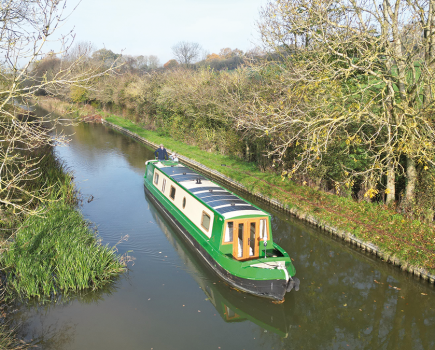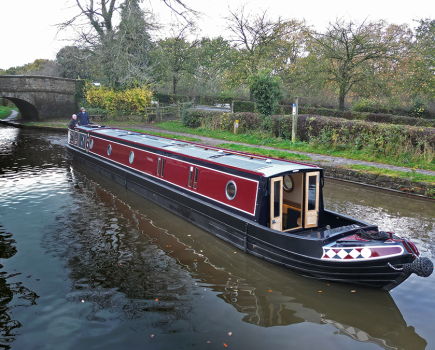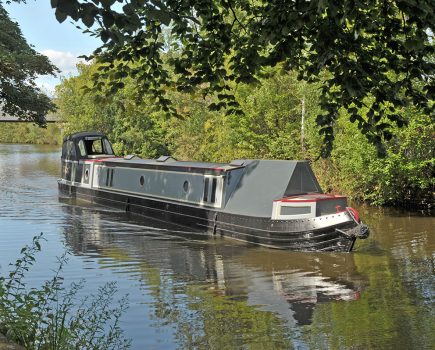If we said the batteries on this Braidbar cost £15k (and that’s just for three) you’d probably think it’s a misprint, but it isn’t and there’s a good reason why so much has been spent on them

Braidbar Boats £195,000
Length: 68ft
Style: Semi-trad
Berths: 2+2+2

Layout: Standard
Engine: Beta 50
Would you like to look at my boat? It’s got really interesting batteries… that isn’t perhaps the most thrilling boat test chat-up line we’ve ever heard, but when you think about it, plenty of boaters are obsessed by their batteries. Are they charging properly? Are they holding their charge? Am I going to have to shell out for new ones? And I can guarantee that any boater who has a battery monitor will check it at least twice a day – and probably a lot more.

Fortunately, this boat has a lot more of interest about it than just its batteries. It’s built by Braidbar Boats and is one of the first where James Attwood had a significant hand in its design, having joined the company from the multi-award-winning Boating Leisure Services. It’s also a longer boat than most we look at, and it’s based on a very fine shell.
But back to batteries – which is one area where technology is moving quite fast and having an impact on narrowboats. We’ve looked at a couple of boats in the past with the latest lithium batteries, but this boat has a whole lithium pack by Mastervolt, which makes choosing the lithium option a bit easier and everything is included.
EXTERIOR

The 68-footer is based on an impressive sheerline Josher shell by Tyler Wilson. Sheerline means there’s a long sweeping curve along the gunwale line, and together with the nice Josher-style curves of the bow it’s a boat that’s well worth standing back and admiring to fully appreciate the attractive lines. And there are details to applaud, too, many of which are pleasingly discrete.
For example, the handrails protrude very slightly from the cabin sides, and the gunwales protrude from the hull side to mimic the wooden handrails and gunwales that old working boats would have had.
They’re actually made by using an extra piece of steel which, I’m reliably informed, makes them incredibly difficult to drill through. This detail is a nod towards working boats but in a much less obvious way than fake rivets.
Across the roof there’s a boatman’s beam, and another beam on the forward edge of the cabin. The cants and handrails have attractive scrolls in the ends, while the dollies at the stern are big and chunky.

The colour scheme is rather subdued, perhaps allowing the lines of the boat to do the talking. The cabin sides are dark green, with red handrails and red panels at the stern; and the sign-writing is by Andy Russell. The roof is traditional raddle red, as are the gunwale tops.
To my eyes the window frames and portholes look a little too modern for the traditional style of the boat, perhaps because they have the latest anti-condensation technology, not just double-glazing but a thermal-break too.
While the mushroom vents on the roof have been given a powder coating to match them (and avoid the need for polishing) other trim, such as the fairleads and tiller arm, are still brass, though.
Jenny Rose is a semi-trad so there are useful lockers on the stern deck, and as it’s a gas-free boat the locker in the nose provides more storage space. There’s also a locker across the front of the well deck to give access to the bow thruster tube, while a stainless steel water tank sits under the deck.

LAYOUT AND FIT-OUT
This boat has a standard layout so the saloon is at the bow. Next comes the galley, with the dinette beyond. The main cabin is further back, with the walk-though shower room behind. There’s another cabin at the stern for visiting family and friends and the layout means that during the night everyone has access to the loo without disturbing anyone else.
The fit-out is a little different from what might be regarded as the usual Braidbar style: there’s no tongue and groove on the cabin sides for example because the owners wanted painted panels instead, but because it’s ash th-e grain shows through. The ceiling also uses painted ash panels.

The paintwork is teamed with ash bulkheads and oak trim, providing a contrast in the wood’s colour and the whole effect is very light and bright. The floor is light oak effect hardwearing Karndean.
SALOON
Starting at the bow, glazed doors and a couple of storage steps bring you down into the saloon. On one side a corner cupboard has a high-level cupboard above. In the opposite corner there’s a Morso Squirrel stove complete with a double insulated flue. The hearth itself has black tiles, but the most noticeable thing is the way it has curves rather than sharp corners, so it merges seamlessly with the under-gunwale unit further along.

The owners had seen something similar and asked Braidbar to come up with a version of the design. It has tall cupboards and a lower section to take a TV, with curved shelves at the far end. There are more shelves built into the half-height bulkheads dividing the saloon from the galley.
The windows have blinds with magnets in the bottom to keep them against the cabin sides when pulled down. Other furniture consists of a couple of captain’s chairs with footstools.
GALLEY

The galley is a very attractive space, with Shaker-style doors painted the same colour as the cabin sides. It means there’s a real sense of continuity throughout. What’s more, the 240-volt fridge and washing machine are hidden behind doors made to look like a door and a drawer.
The worktops are black granite and on one side there’s an inset white sink with a milled drainer. As well as the normal tap, another provides a filtered drinking water supply. On the opposite side there’s a Neff induction four-ring hob set into the worktop (this is an all-electric boat, remember). Above it, on this side only, there are a couple of high level cupboards, with a mug rack between them.
A Neff oven is at eye level in a full height unit and it has a Neff microwave above with a pan cupboard below. Opposite this there’s an under-gunwale cupboard and wine rack.
The galley has a Houdini hatch in the roof, so it’s very light and bright.

DINETTE
One of Braidbar’s trademark C-shaped bulkheads provides a division between the galley and the dinette, although the C is a bit more compact than usual because of the full-height oven unit.
The dinette itself is raised and there are glazed side doors on both sides of the boat, so it’s easy to see out when you’re eating. The table is extra wide, another Braidbar staple, and drops down to make a guest bed. There’s storage in the bases of the seats and under the raised part of the floor. A high-level display unit on the rear bulkhead includes a Braidbar cruciform motif; the bulkhead itself shows what lovely grain patterns the ash has.

CABIN
The cabin has an inline bed that extends to five-feet wide. There are reading lights above the bed head and a run of high-level cupboards extends the length of it over the porthole. There’s also some long-term storage under the bed (where the loo holding tank is also located).
The main storage for clothes comes in the form of a substantial wardrobe with a combination of hanging and shelf space. The doors are nicely made in oak and there’s a tall mirror alongside. There’s another Houdini hatch in the roof, while a white ‘school’ radiator completes a comfortable space.

SHOWER ROOM
The shower room is a walk-through with the loo, a Vetus macerator, positioned on one side so it’s hidden when the door to the back cabin is open – it’s a neat move because it means you don’t have to look at it every time you walk through the boat.
The shower is a generous 1,000 x 900mm and lined with sparkly white Mermaid board. The space between the shower and the hull side houses the calorifier and is accessed by a lift-off panel.

Having the calorifier so close to the shower means the hot water comes through very quickly, with little wasted water.
In the opposite corner there’s a cupboard unit with a black granite worktop, a white inset basin and a mirror.
BACK CABIN

This room is intended as a guest cabin, so there are benches both sides for sitting and sleeping, with storage underneath (although some of the space houses the boat’s batteries). There are high-level cupboards both sides too, with nice arched sections over the portholes.
At the stern, a set of ladder steps leads up to the semi-trad back deck. There’s a wet locker on one side, with the electrical cupboard on the other. The fuse panel and all the gauges and switches are also sited here.
TECHNICAL

Jenny Rose has a Beta 50 engine which should provide plenty of power even if this boat is longer than average. The bow thruster is 95kgf Vetus.
It’s the electrical side of things which is the most interesting technically. We’ve seen a handful of boats in the past with lithium batteries, but this is the first one we’ve seen with Mastervolt’s lithium pack; it means that the whole system can be bought as one, including an alternator and a box of tricks that manages the charging and discharging of the batteries, compensating for any imbalance between each and ensuring they don’t over-charge. If it senses anything amiss, it will shut down.
This boat has three of Mastervolt’s latest lithium batteries, each providing 180Ah at 24 volts. The firm says these batteries offer a 70 percent saving in volume and weight compared with normal lead acid batteries. It also says they’ll last three times as long, perhaps 15 years (although some experts reckon they’ll actually last 20 or 30) and the charging is very fast.
When we took the boat out its batteries were around 40 percent charged and an hour later they were up at 90. The whole bank could be charged from empty to full in under three hours and it should then last two or three days.
Another advantage of lithium batteries is that you can run them right down to 80 percent discharged (in fact the monitor is set so that it reads zero at this point). That gives you almost twice the available power of lead acid batteries, which are damaged if they go below 50 percent.
What’s more, lithiums continue to deliver their full voltage right up to the last moment. If you had a more everyday set up, with lead acid batteries and a 12-volt system you’d need a bank totalling well over 1,000Ah. The disadvantage (there had to be one, didn’t there?) is the price. Each of these batteries costs an eye-watering amount – a shade under £5,000.
No doubt the price will come down in the future, but it’s a significant investment if you decide to go down the lithium route. Of course if they really do last as long as some people predict, they could be the only batteries you ever buy.
As there’s such a lot of power available, it makes sense to use it for things such as cooking. To provide the 240-volt supply, this boat has two 3.5kW Mastervolt inverters.
Central heating and hot water comes from a Webasto boiler.
ON THE WATER
We like the handling of Tyler Wilson boats and it seems their 68ft ones are just as good as the shorter models we’ve tested. This boat goes where it’s pointed and responds well to the tiller. The engine is nice and quiet, yet provides plenty of power.
The extra length is, of course, very noticeable when it comes to turning around; you really need to use the widest part of the winding hole and the bow thruster offers plenty of grunt to give you a helping hand if needed.
THE OWNERS
David and Frances Shields have an extensive boating history. David has done a lot of sailing at sea, perhaps not surprising as the couple live on the South Coast. But Frances isn’t a fan of salt water and waves, so the canals seemed like a good option: it’s still a boat, but the water is calmer and there’s plenty of countryside around to enjoy.
The couple have two daughters (whose names inspired the name of the boat), and the family have taken plenty of boating holidays over the years, both on the Broads and the canals. For more than a decade they’ve been hiring once or twice a year.
David is a structural engineer and hopes he’ll be able to work from the boat. Frances is retired from her job as a lecturer in English.
VERDICT
The Mastervolt lithium pack fitted to this boat illustrates that these batteries are becoming more mainstream and an easier option to choose. Many people will be put off by the price, but the fact they last a long time and can be charged so quickly will appeal to a lot of boaters.
The price of the lithium system helps make Jenny Rose quite an expensive boat. It cost £195,000 – and that’s a lot of money in anyone’s book. But don’t forget that the batteries alone are almost £15,000 of that, and then there’s a second inverter, too.
In addition, this boat is 10ft longer than most we look at. If you went down the route of having a more typical length of boat with a more traditional set up, a Braidbar would start at around £125,000.
While the batteries are important and interesting, there’s clearly a lot more to this boat. The shell looks great from a distance and close up has lots of pleasing features. The fit-out is high quality, as you’d expect, and it’s a bit of a departure in style from many Braidbars we’ve seen before, thanks both to the owners having a clear idea what they wanted and the addition of James Attwood to the team.
TECHNICAL SPECIFICATIONS
Length: 68ft
Beam: 6ft 10in
Shell: Tyler Wilson, tylerwilsonboats.com
Style: Semi-trad
Layout: Standard
Berths: 2+2+2
Fit-out: Ash, painted ash and oak
Engine: Beta 50
Tel: 01452 723492, betamarine.co.uk
Inverter: 2 x Mastervolt 3.5kW, mastervolt.com
Batteries: Mastervolt MLI Ultra 24/5000, mastervolt.com
Bow Thruster: Vetus, vetus.com
DESIGN AND DECOR
Hob: Neff induction £349, neff-home.com
Water filter system: Seagull, purewateronline.co.uk £413
Image(s) provided by:
Archant







